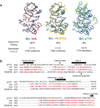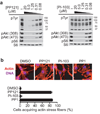Targeted polypharmacology: discovery of dual inhibitors of tyrosine and phosphoinositide kinases
- PMID: 18849971
- PMCID: PMC2880455
- DOI: 10.1038/nchembio.117
Targeted polypharmacology: discovery of dual inhibitors of tyrosine and phosphoinositide kinases
Abstract
The clinical success of multitargeted kinase inhibitors has stimulated efforts to identify promiscuous drugs with optimal selectivity profiles. It remains unclear to what extent such drugs can be rationally designed, particularly for combinations of targets that are structurally divergent. Here we report the systematic discovery of molecules that potently inhibit both tyrosine kinases and phosphatidylinositol-3-OH kinases, two protein families that are among the most intensely pursued cancer drug targets. Through iterative chemical synthesis, X-ray crystallography and kinome-level biochemical profiling, we identified compounds that inhibit a spectrum of new target combinations in these two families. Crystal structures revealed that the dual selectivity of these molecules is controlled by a hydrophobic pocket conserved in both enzyme classes and accessible through a rotatable bond in the drug skeleton. We show that one compound, PP121, blocks the proliferation of tumor cells by direct inhibition of oncogenic tyrosine kinases and phosphatidylinositol-3-OH kinases. These molecules demonstrate the feasibility of accessing a chemical space that intersects two families of oncogenes.
Figures








Comment in
-
Killing two kinase families with one stone.Nat Chem Biol. 2008 Nov;4(11):648-9. doi: 10.1038/nchembio1108-648. Nat Chem Biol. 2008. PMID: 18936744 No abstract available.
Similar articles
-
Synthesis, biological evaluation and docking studies of 4-amino substituted 1H-pyrazolo[3,4-d]pyrimidines.Eur J Med Chem. 2008 Dec;43(12):2665-76. doi: 10.1016/j.ejmech.2008.01.034. Epub 2008 Feb 6. Eur J Med Chem. 2008. PMID: 18342402
-
Potentiation of antileukemic therapies by the dual PI3K/PDK-1 inhibitor, BAG956: effects on BCR-ABL- and mutant FLT3-expressing cells.Blood. 2008 Apr 1;111(7):3723-34. doi: 10.1182/blood-2007-09-114454. Epub 2008 Jan 9. Blood. 2008. PMID: 18184863 Free PMC article.
-
Tyrosine kinase inhibition effects of novel Pyrazolo[1,5-a]pyrimidines and Pyrido[2,3-d]pyrimidines ligand: Synthesis, biological screening and molecular modeling studies.Bioorg Chem. 2018 Aug;78:312-323. doi: 10.1016/j.bioorg.2018.03.009. Epub 2018 Mar 26. Bioorg Chem. 2018. PMID: 29625271
-
Bruton Kinase Inhibitors in Chronic Lymphocytic Leukemia.Anticancer Agents Med Chem. 2017;17(8):1040-1045. doi: 10.2174/1871520616666160928153342. Anticancer Agents Med Chem. 2017. PMID: 27697038 Review.
-
Tyrosine kinases as targets in cancer therapy - successes and failures.Expert Opin Ther Targets. 2003 Apr;7(2):215-34. doi: 10.1517/14728222.7.2.215. Expert Opin Ther Targets. 2003. PMID: 12667099 Review.
Cited by
-
Significance of filamin A in mTORC2 function in glioblastoma.Mol Cancer. 2015 Jul 2;14:127. doi: 10.1186/s12943-015-0396-z. Mol Cancer. 2015. PMID: 26134617 Free PMC article.
-
DNA-PK promotes activation of the survival kinase AKT in response to DNA damage through an mTORC2-ECT2 pathway.Sci Signal. 2022 Jan 4;15(715):eabh2290. doi: 10.1126/scisignal.abh2290. Epub 2022 Jan 4. Sci Signal. 2022. PMID: 34982576 Free PMC article.
-
Ribosomal Protein S6: A Potential Therapeutic Target against Cancer?Int J Mol Sci. 2021 Dec 21;23(1):48. doi: 10.3390/ijms23010048. Int J Mol Sci. 2021. PMID: 35008473 Free PMC article. Review.
-
mTOR kinase is a therapeutic target for respiratory syncytial virus and coronaviruses.Sci Rep. 2021 Dec 24;11(1):24442. doi: 10.1038/s41598-021-03814-7. Sci Rep. 2021. PMID: 34952911 Free PMC article.
-
Chemoproteomic Profiling Uncovers CDK4-Mediated Phosphorylation of the Translational Suppressor 4E-BP1.Cell Chem Biol. 2019 Jul 18;26(7):980-990.e8. doi: 10.1016/j.chembiol.2019.03.012. Epub 2019 May 2. Cell Chem Biol. 2019. PMID: 31056462 Free PMC article.
References
-
- Krause DS, Van Etten RA. Tyrosine kinases as targets for cancer therapy. N Engl J Med. 2005;353:172–187. - PubMed
-
- Sebolt-Leopold JS, English JM. Mechanisms of drug inhibition of signalling molecules. Nature. 2006;441:457–462. - PubMed
-
- Shaw RJ, Cantley LC. Ras, PI(3)K and mTOR signalling controls tumour cell growth. Nature. 2006;441:424–430. - PubMed
-
- Samuels Y, et al. High frequency of mutations of the PIK3CA gene in human cancers. Science. 2004;304:554. - PubMed
-
- Samuels Y, Velculescu VE. Oncogenic mutations of PIK3CA in human cancers. Cell Cycle. 2004;3:1221–1224. - PubMed
Publication types
MeSH terms
Substances
Associated data
- Actions
- Actions
- Actions
- Actions
- Actions
- Actions
- PubChem-Substance/53799218
- PubChem-Substance/53799219
- PubChem-Substance/53799220
- PubChem-Substance/53799221
- PubChem-Substance/53799222
- PubChem-Substance/53799223
- PubChem-Substance/53799224
- PubChem-Substance/53799225
- PubChem-Substance/53799226
- PubChem-Substance/53799227
- PubChem-Substance/53799228
- PubChem-Substance/53799229
- PubChem-Substance/53799230
- PubChem-Substance/53799231
- PubChem-Substance/53799232
- PubChem-Substance/53799233
- PubChem-Substance/53799234
- PubChem-Substance/53799235
- PubChem-Substance/53799236
- PubChem-Substance/53799237
- PubChem-Substance/53799238
- PubChem-Substance/53799239
- PubChem-Substance/53799240
- PubChem-Substance/53799241
- PubChem-Substance/53799242
- PubChem-Substance/53799243
- PubChem-Substance/53799244
- PubChem-Substance/53799245
- PubChem-Substance/53799246
- PubChem-Substance/53799247
- PubChem-Substance/53799248
- PubChem-Substance/53799249
- PubChem-Substance/53799250
- PubChem-Substance/53799251
- PubChem-Substance/53799252
- PubChem-Substance/53799253
- PubChem-Substance/53799254
- PubChem-Substance/53799255
- PubChem-Substance/53799256
- PubChem-Substance/53799257
- PubChem-Substance/53799258
- PubChem-Substance/53799259
- PubChem-Substance/53799260
- PubChem-Substance/53799261
- PubChem-Substance/53799262
- PubChem-Substance/53799263
- PubChem-Substance/53799264
- PubChem-Substance/53799265
- PubChem-Substance/53799266
- PubChem-Substance/53799267
- PubChem-Substance/53799268
- PubChem-Substance/53799269
- PubChem-Substance/53799270
- PubChem-Substance/53799271
- PubChem-Substance/53799272
- PubChem-Substance/53799273
- PubChem-Substance/53799274
- PubChem-Substance/53799275
- PubChem-Substance/53799276
- PubChem-Substance/53799277
- PubChem-Substance/53799278
- PubChem-Substance/53799279
- PubChem-Substance/53799280
- PubChem-Substance/53799281
- PubChem-Substance/53799282
- PubChem-Substance/53799283
- PubChem-Substance/53799284
- PubChem-Substance/53799285
- PubChem-Substance/53799286
- PubChem-Substance/53799287
- PubChem-Substance/53799288
- PubChem-Substance/53799289
- PubChem-Substance/53799290
- PubChem-Substance/53799291
- PubChem-Substance/53799292
- PubChem-Substance/53799293
- PubChem-Substance/53799294
- PubChem-Substance/53799295
- PubChem-Substance/53799296
- PubChem-Substance/53799297
- PubChem-Substance/53799298
- PubChem-Substance/53799299
- PubChem-Substance/53799300
- PubChem-Substance/53799301
- PubChem-Substance/53799302
- PubChem-Substance/53799303
- PubChem-Substance/53799304
- PubChem-Substance/53799305
- PubChem-Substance/53799306
- PubChem-Substance/53799307
- PubChem-Substance/53799308
- PubChem-Substance/53799309
- PubChem-Substance/53799310
- PubChem-Substance/53799311
- PubChem-Substance/53799312
- PubChem-Substance/53799313
- PubChem-Substance/53799314
- PubChem-Substance/53799315
- PubChem-Substance/53799316
- PubChem-Substance/53799317
- PubChem-Substance/53799318
- PubChem-Substance/53799319
- PubChem-Substance/53799320
- PubChem-Substance/53799321
- PubChem-Substance/53799322
- PubChem-Substance/53799323
- PubChem-Substance/53799324
- PubChem-Substance/53799325
- PubChem-Substance/53799326
- PubChem-Substance/53799327
- PubChem-Substance/53799328
- PubChem-Substance/53799329
- PubChem-Substance/53799330
- PubChem-Substance/53799331
- PubChem-Substance/53799332
- PubChem-Substance/53799333
- PubChem-Substance/53799334
- PubChem-Substance/53799335
- PubChem-Substance/53799336
- PubChem-Substance/53799337
- PubChem-Substance/53799338
- PubChem-Substance/53799339
- PubChem-Substance/53799340
- PubChem-Substance/53799341
- PubChem-Substance/53799342
- PubChem-Substance/53799343
- PubChem-Substance/53799344
- PubChem-Substance/53799345
- PubChem-Substance/53799346
- PubChem-Substance/53799347
- PubChem-Substance/53799348
- PubChem-Substance/53799349
- PubChem-Substance/53799350
- PubChem-Substance/53799351
- PubChem-Substance/53799352
- PubChem-Substance/53799353
- PubChem-Substance/53799354
- PubChem-Substance/53799355
- PubChem-Substance/53799356
- PubChem-Substance/53799357
- PubChem-Substance/53799358
- PubChem-Substance/53799359
- PubChem-Substance/53799360
- PubChem-Substance/53799361
- PubChem-Substance/53799362
- PubChem-Substance/53799363
- PubChem-Substance/53799364
- PubChem-Substance/53799365
- PubChem-Substance/53799366
- PubChem-Substance/53799367
- PubChem-Substance/53799368
- PubChem-Substance/53799369
- PubChem-Substance/53799370
- PubChem-Substance/53799371
- PubChem-Substance/53799372
- PubChem-Substance/53799373
- PubChem-Substance/53799374
- PubChem-Substance/53799375
- PubChem-Substance/53799376
- PubChem-Substance/53799377
- PubChem-Substance/53799378
- PubChem-Substance/53799379
- PubChem-Substance/53799380
- PubChem-Substance/53799381
- PubChem-Substance/53799382
- PubChem-Substance/53799383
- PubChem-Substance/53799384
- PubChem-Substance/53799385
- PubChem-Substance/53799386
- PubChem-Substance/53799387
- PubChem-Substance/53799388
- PubChem-Substance/53799389
- PubChem-Substance/53799390
- PubChem-Substance/53799391
- PubChem-Substance/53799392
- PubChem-Substance/53799393
- PubChem-Substance/53799394
- PubChem-Substance/53799395
- PubChem-Substance/53799396
- PubChem-Substance/53799397
- PubChem-Substance/53799398
- PubChem-Substance/53799399
- PubChem-Substance/53799400
- PubChem-Substance/53799401
- PubChem-Substance/53799402
- PubChem-Substance/53799403
- PubChem-Substance/53799404
- PubChem-Substance/53799405
- PubChem-Substance/53799406
- PubChem-Substance/53799407
- PubChem-Substance/53799408
- PubChem-Substance/53799409
- PubChem-Substance/53799410
- PubChem-Substance/53799411
- PubChem-Substance/53799412
- PubChem-Substance/53799413
- PubChem-Substance/53799414
- PubChem-Substance/53799415
- PubChem-Substance/53799416
- PubChem-Substance/53799417
- PubChem-Substance/53799418
- PubChem-Substance/53799419
- PubChem-Substance/53799420
- PubChem-Substance/53799421
- PubChem-Substance/53799422
- PubChem-Substance/53799423
- PubChem-Substance/53799424
- PubChem-Substance/53799425
- PubChem-Substance/53799426
- PubChem-Substance/53799427
- PubChem-Substance/53799428
- PubChem-Substance/53799429
- PubChem-Substance/53799430
- PubChem-Substance/53799431
- PubChem-Substance/53799432
- PubChem-Substance/53799433
- PubChem-Substance/53799434
- PubChem-Substance/53799435
- PubChem-Substance/53799436
- PubChem-Substance/53799437
- PubChem-Substance/53799438
- PubChem-Substance/53799439
- PubChem-Substance/53799440
- PubChem-Substance/53799441
Grants and funding
LinkOut - more resources
Full Text Sources
Other Literature Sources
Chemical Information
Molecular Biology Databases
Miscellaneous

